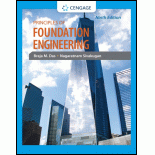
Concept explainers
Repeat Problem 11.1 based on limit state design, using the factors given in Table 11.4.
11.1 A continuous foundation is required in a soil where
Want to see the full answer?
Check out a sample textbook solution
Chapter 11 Solutions
Principles of Foundation Engineering
- MANUALLY DRAW THE FLOW NET. SHOW THE SCALE USED. do not just explain how to draw it, give me a completed flow net.arrow_forwardIn a simulation experiment on a single lane road, one vehicle is travelling at 18 m/s.After 1.5seconds, the vehicle suddenly accelerates at a rate of 1.5 m/s2 for the next2 seconds and remains0 acceleration then after. Simulate the behavior of subsequent vehicle with an initial speedof16 m/s using GM car following model for the first 3 seconds if the initial distanceheadwayis 20 m. Tabulate the results. Assume headway exponent 1.2, speed exponent1.5, sensitivitycoefficient 0.8, reaction time 0.6 seconds, and update interval of0.3 seconds.arrow_forwardFORWARD FROM POINT B TO POINT A GIVEN THE FOLLOWING: POINT BN=13,163,463.03'E=3,072,129.30' DIRECTION FROM B TO A (NAZ)=276.07529° DISTANCE FROM B TO A = 10.00'arrow_forward
- It proposed to provide pile foundation for a heavy column; the pile group consisting of 4 piles. placed at 2.0 m centre to centre, forming a square pattern. The under-ground soil is clay, having cu at surface as 60 kN/m², and at depth 10 m, as 100 kN/m². Compute the allowable column load on the pile cap with factor of safety of 3.0, if the piles are circular having diameters 0.5 m each and length as 10 m.arrow_forwardAt a particular section on a highway the following headways are observed: 0.04, 1.37,1.98,5.09, 3.00, 2.32, 2.54, 1.37, 0.94, 1.79, 1.10, 6.24, 4.82, 2.77, 4.82, 6.44. Fit an exponentialdistribution and compare the observed and estimated mean. Check the fit at the 5% level ofsignificance.arrow_forwardH.W: 1. Find the center of mass and the moment of inertia and radius of gyration about the y-axis of thin rectangular plate cut from the first quadrant by the lines x = 6 and y = 1 if (x, y) = x+y+1 2. Find the moment of inertia and radius of gyration about the coordinate axes of a thin rectangular plate of constant density & bounded by the lines x = 3 and y = 3 in the first quadrant.arrow_forward
- Please solve manually and follow all rules for flow net construction. Provide a scale such that the flow net produced can be copied.arrow_forwardPlease solve manually, and give any tips on how I can manually recreate the flow net you provide. Thanks.arrow_forwardA group of nine piles. 12m long and 350 mm in diameter, is to be arrenged in a square form in clay soil with an average unconfined compressive strength of 60 KN/m^2. Work out center to center spacing of the piles for a group effeciency factor of 1, Neglect bearing at the tip of the piles.arrow_forward
- SOLVE BY NEWTON - RAPHSON METHOD: The equation x³-3x-4=0 is of the form f(x) = 0 where f(1) 0 so there is a solution to the equation between 1 and 3. We shall take this to be 2, by bisection. Find a better approximation to the root.arrow_forwardKindly help to provide answers, elaborate with examples and provide useful links for learning purposes. this is regarding building diagnosis.arrow_forwardpounds of steel need to be purchased for the roof plan a table with various steel types and the quantity needed The colums are 18 feet high and weigh 76 ponds per foot include a structural steel material list for the roof framing planarrow_forward
 Principles of Foundation Engineering (MindTap Cou...Civil EngineeringISBN:9781337705028Author:Braja M. Das, Nagaratnam SivakuganPublisher:Cengage Learning
Principles of Foundation Engineering (MindTap Cou...Civil EngineeringISBN:9781337705028Author:Braja M. Das, Nagaratnam SivakuganPublisher:Cengage Learning Principles of Foundation Engineering (MindTap Cou...Civil EngineeringISBN:9781305081550Author:Braja M. DasPublisher:Cengage Learning
Principles of Foundation Engineering (MindTap Cou...Civil EngineeringISBN:9781305081550Author:Braja M. DasPublisher:Cengage Learning Fundamentals of Geotechnical Engineering (MindTap...Civil EngineeringISBN:9781305635180Author:Braja M. Das, Nagaratnam SivakuganPublisher:Cengage Learning
Fundamentals of Geotechnical Engineering (MindTap...Civil EngineeringISBN:9781305635180Author:Braja M. Das, Nagaratnam SivakuganPublisher:Cengage Learning Principles of Geotechnical Engineering (MindTap C...Civil EngineeringISBN:9781305970939Author:Braja M. Das, Khaled SobhanPublisher:Cengage Learning
Principles of Geotechnical Engineering (MindTap C...Civil EngineeringISBN:9781305970939Author:Braja M. Das, Khaled SobhanPublisher:Cengage Learning



